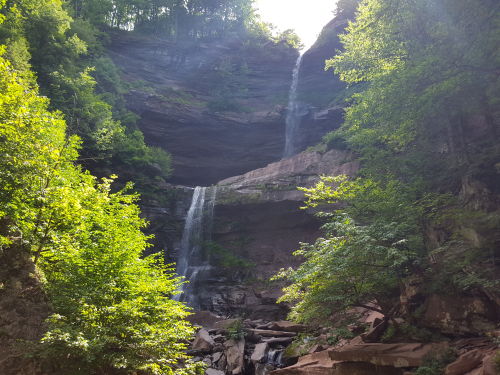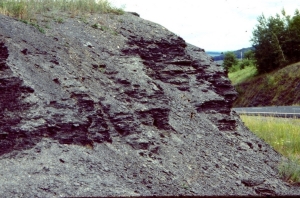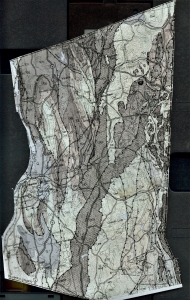Footprint of a Mountain Range 3-26-20
Footprints of a Mountain Range
Stories in Stone – The Columbia County Independent
Oct. 3, 2003
Updated by Robert and Johanna Titus
We normally pay so little notice of the many rock outcroppings that we pass by in our daily lives. Why should we; they are just rocks? But there is so much to see if you know what to look for. Today we would like to give you a reason to look at rocks and a good one. Columbia County is a landscape that has many geological pasts. One of them shows a history of intense mountain building. That’s curious as there are no real mountains in our area. There are the Berkshires and the Taconics, but they are mostly pretty little hills. How could there ever have been real mountains here?
But there were, and in fact Columbia County was once part of one of the world’s great mountain ranges. Let’s learn how to read the evidence. We will describe what you can see at one good location and then you can look for the same thing in the rocks where you live. Travel to the intersection of Rts. 23 and 9G. Across from the Stuart’s is a fine exposure of rock. Look for horizons of thinly laminated black shale, and thicker bedded black sandstone. All this is a unit of rock called the Normanskill Formation and it dates back about 450 million years to a time called the Ordovician time period. At first these look like nondescript rocks but there is so much more.
Let’s do the fundamentals. These rocks are stratified, and each layer is a moment in time. Back in the Ordovician this location was at was the bottom of the sea and each horizon of rock was, briefly, the sea floor. Sometimes that sea floor was mud and that accounts for the shale. Sometimes it was a sandy bottom and that now makes the sandstone. Touch any layer of rock and you are touching an ancient ocean bottom, literally. We never tire of that notion. Each stratum had its turn and then a depositional event brought a new layer of sediment and created a new sea floor. If you get a chance to scuba dive across the bottom of a sea you will see its floor and you will have the impression that this is something that is, forever and forever, permanent. But our rocks tell a different story; sea floors are ephemeral.
And sea floors are supposed to be under a lot of ocean; what is this one doing on dry land? The question gets worse when you realize that this sea floor was once at the bottom of a very deep submarine trench, perhaps 20,000 feet deep. Clearly there has, since the Ordovician, been a lot of uplift. It gets curiouser and curiouser!
Sea floors, today, are almost always flat. Look over this outcrop and you will find that none of these layers are horizontal. There is more to this story; let’s keep looking. There are four road signs here. The first is a black and white Rte. 23 sign. Just to the east are three yellow road signs; the middle one speaks of a left turn. Take a good look at the strata between the first two signs. Most of the bedding here dips steeply to the east. Clearly something has happened to these once flat-lying strata. They have been tilted. Imagine, for a moment, how much it takes to move, let alone tilt, a great mass of rock. Something very serious happened here and that something was mountain building.
And, there is still more. Halfway between the first two yellow sign look for a sequence of strata that have been sharply folded into a smiley face U. Once again, imagine the energy needed to fold rocks. Keep on walking east and notice that, between the second and third yellow signs that some of the strata have lost their eastward dip and they are nearly vertical. All in all, the rocks don’t just speak to us of folding; they speak of intense deformation.
Uplift, tilting and folding are the hallmarks of mountain building and that’s what happened here, but when? Drive down the road 2.3 miles and you will reach the intersection of Routes 23 and 9. There, on the left, is a fine exposure of gray limestone called the Manlius Limestone. These rocks are younger, about 50 million years younger. They belong to a time called the early Devonian, and that makes them a mere 400 million years old. Take a good look at the lower 20 feet of strata here. These beds are gently dipping to the east, but this deformation is very mild compared to what we saw back down the road. Here there is no folding and no extreme tilting of the rocks; they lie essentially as they were deposited in the Devonian. There has never been a time when these beds were deformed. That tells us a lot.
Obviously, mountain building deformation came after the Ordovician, because those rocks are deformed. But, also, deformation must have been before the Devonian, as those rocks are not deformed. There must have been a great mountain building event between the Ordovician and Devonian and there was. Our mountain building event is called, by geologists, the Taconic Orogeny. This event reached its peak during a time called the Silurian Period and that, of course, is the time between the Ordovician and Devonian. From this location on Rte. 23 look east and, in your mind’s eye, see the profile of the Taconic Mountains that once towered on this horizon. They probably rose 15 or 20 thousand feet into the sky and so they rivaled the Rockys and Andes of today’s world.
But they are all gone, or at least, they are nearly all gone. Only the Berkshires and the Taconics remain. The rest has slowly, and we mean very slowly, eroded away. Look around you, do you see much erosion going on? This is geology and it takes a very long time.
Our story has been about these Rte. 23 outcroppings but remember that we would like you to take what you have learned here and look at the rocks near you. Can you see folding or tilting in the rocks? If so, then you are looking at the same mountain building events. Wherever you are, look up. Above you there once were tens of thousands, of feet of mountain. Now, look at the rocks in your area again. You are looking into the very core of a great mountain range. What we call Columbia County is something that you might find 20,000 feet below the top of Mount Everest. Changes your point of view, doesn’t it?
Contact the authors at randjtitus@prodigy.net. Join their facebook page “The Catskill Geologist.”


